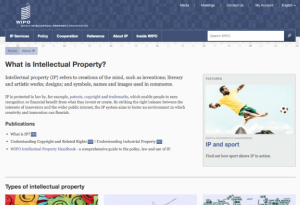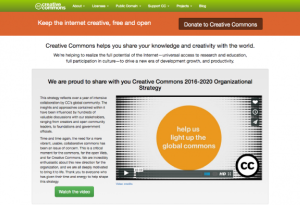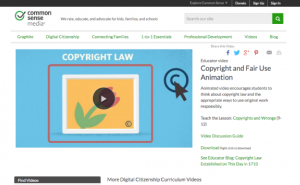Intellectual Property and Licensing
Back to Top
|
 |
|
WIPO: What is Intellectual Property?
|
|
|
As this excellent site from the World Intellectual Property Organization (WIPO) so succinctly explains, intellectual property (IP) refers to creations of the mind, such as inventions; literary and artistic works; designs; and symbols, names, and images used in commerce. Types of IP include Copyright, Patents, Trademarks, Industrial Designs, and Geographical Indications. As a whole, the WIPO website is broadly informative and readers will find a number of excellent Publications. For example, the freely downloadable PDF "What is IP?" contains an introduction and pithy chapters on the subjects of patents, trademarks, industrial design, and geographical indications, as well as a chapter dedicated to copyright and related rights. For a more comprehensive treatment, readers will also find the freely downloadable "WIPO Intellectual Property Handbook." [CNH] |
|





|
|
 |
|
Intellectual Property Law: Why Should I Care?
|
|
|
This entertaining site from the UCLA Library helps readers understand the elaborate case law of intellectual property through illustrations, quizzes, and colorful text boxes. After perusing the homepage, readers may like to explore the various sections of the site. The first, Intellectual Property, includes 15 subsections that explain the basics of copyright, fair use, patents, trademarks, and other related topics before offering a quiz to help readers maximize their learning. Need a File, Share a File delves into copyright as related to the ever more common practice of file sharing, while Citing and Documenting Sources provides an excellent primer on how to avoid plagiarism and how to properly cite various types of media. For readers working in a college context, this sterling resource from UCLA libraries can provide students and professors with everything they need to know about intellectual property in academia. [CNH] |
|





|
|
 |
|
Ten Simple Rules to Protect Your Intellectual Property
|
|
|
Scientists of all kinds will benefit from reading this excellent article from the open access journal, PLoS: Computational Biology. The authors, each of whom is well established in his field, offer ten simple rules that might help researchers protect their intellectual property. These include tips such as: Get Professional Help, Know Your (Intellectual Property) Rights, Think about Why You Want IP, Be Realistic about What You Can, and Cannot, Protect, Keep Your Idea Secret until You Have Filed a Patent Application, and others. Each rule is accompanied by several explanatory paragraphs that elucidate and clarify the points, making for an exceptionally useful list of advice for scientists that would like to protect their innovative work and develop it for the next phase of inquiry and results.[CNH] |
|





|
|
 |
|
 |
|
Creative Commons
|
|
|
Creative Commons is a nonprofit that offers free legal tools to creative people who would like to share their work under specified conditions. On the site, readers may like to start by searching the commons, which they can do using the convenient search feature. A search turns up results from the OpenClipArt library, Google, Wikimedia Commons, SoundCloud, and other sources - all of it pre-approved for legal use. The site also features a number of compelling features for users who would like to license their own content. For example, under Licenses, users will find categories such as About the Licenses, Choose a License, and Things to know before licensing to understand available licensing options for particular products. On the other hand, readers who would like to use the work of others may also read about Best practices for attribution and Getting permission. Finally, the Creative Commons blog is a regularly updated source of information about licensing, public domain work, and the various artists and others that use Creative Commons to license their work. [CNH] |
|





|
|
 |
|
Foter Blog: How To Attribute Creative Commons Photos
|
Arts |
|
With more than 227 million images available for legal use on its site, Creative Commons is a phenomenal resource for bloggers, educators, web designers, and many others working in digital images. However, according to the researchers at Foter Blog, more than 90 percent of Creative Commons photos are not attributed at all. Of those that are attributed, less than 10 percent are attributed properly. This surprisingly clear infographic provides concise directions for how, exactly, to attribute Creative Commons content. First, the infographic explains what a Creative Commons license is and what it allows users to do. Then it explains the different conditions (Attribution, Non-Commercial, No Derivative Works, and Share Alike) and what they mean. Finally, the graphic offers some statistics on the most popular licenses and categories before reviewing how users should attribute photos, using a simple four-step process that includes citing the author, the title of the work, the license type, and the copyright notices. For readers who would like to understand how to properly attribute Creative Commons content, this infographic is a must see. [CNH] |
|





|
|
 |
|
YouTube: A Shared Culture
|
|
|
This snappy and succinct 3-minute video offers readers a concise explanation of what Creative Commons is, what it does, and how artists, corporations, musicians, bloggers, and anyone else might make use of it. Put simply, according the video, Creative Commons is like a public park: anyone can use a public park, as long as they follow certain guidelines. Likewise, anyone can use the materials on the Creative Commons website, as long as they correctly attribute the work, based on the Creative Commons licensing system. In addition, artists and others who would like to share their work may choose exactly how they would like it to be used. For example, can it be used for commercial purposes, or not? Or, can people use it to make derivative work? Or, do the users need to share alike? Creative Commons seeks to build a global community of shared ideas, and this video explains the process. [CNH] |
|





|
|
 |
|





















